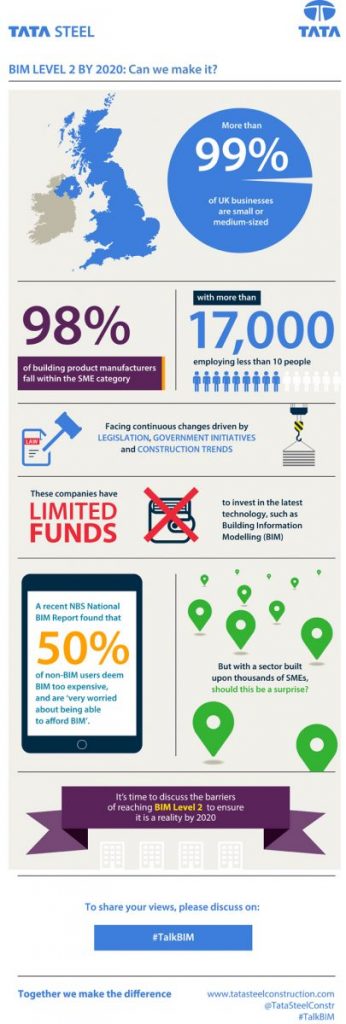Tata Steel’s Alex Small highlights the challenges of implementing BIM Level 2 for an industry largely made up of small and medium-sized enterprises
Within the construction industry, 98% of building product manufacturers fall into the SME category, with over 17,000 employing less than ten people. Facing an ever-changing climate affected by evolving legislation, government initiatives, global finances and construction trends; SMEs have limited flexibility and funds to invest in the latest practices and technologies.
This is particularly pertinent when considering BIM adoption and the recently passed 2016 government target of ensuring all public-sector construction projects comply with BIM Level 2.
From the end-user viewpoint, the NBS National BIM Report for Manufacturers concluded more than 71% of the design community respondents need manufacturers to provide them with BIM objects. Saving essential time and highlighting any technical issues within the design stage, BIM offers tangible supply chain benefits.
However, when surveying non-BIM users, the NBS report found 50% deem BIM too expensive to be considered ‘at the moment’ and are ‘very worried about being able to afford BIM’.
But for a sector built upon the contribution of thousands of SMEs, should this be a surprise? Requiring vast quantities of time, effort and manpower, not to mention the additional training to fully understand their BIM responsibilities, creating BIM objects and compiling the structured data in required formats for even a small product portfolio can be a costly and confusing venture.
This is due to the various ways in which manufacturers can provide their product information. If they choose to generate 3D objects then what formats should they be produced in? Revit? ArchiCAD? Tekla? IFC? Following this, which hosting companies should be used to make these objects available to the supply chain?

Managing data
Even simply providing data isn’t a straightforward process, as manufacturers need to consider what datasets to offer. Following the standards is the sensible route and offering IFC and COBie formats is logical, but if an asset isn’t maintainable is it desired? Furthermore, do you include Environmental Product Declaration (EPD) data? What about the National BIM Library (NBS)? Then, once the data is collated, how is it stored and managed?
Further complicating the process, data naming conventions vary from manufacturer to manufacturer. This makes it increasingly difficult for hosting companies to outline what data they require and for users to easily compare BIM objects of two similar products.
With naming fields being ever so slightly different, a computer cannot identify or correctly align them. For example, if two manufacturers classify the length of a beam as ‘length’ and ‘total length’, a computer will not be able to align the characteristics for an easy comparison.
LEXiCON should go some way to simplifying this process. A web-based tool, LEXiCON provides a way for the industry to share product data consistently, using a plain language dictionary developed by relevant industry bodies.
However, the initial upfront investment remains large and when considering the nature of SMEs, who make up a large base of the construction industry and have smaller budgets, less manpower and free time – will BIM ever be adopted by the whole sector?
Solutions
There are many potential solutions that can ease the adoption of new digital working methods throughout the supply chain, including the open exchange and sharing of product data templates and best practice. This will enable the learnings from each BIM manager’s journey to be passed on, creating a smoother and more defined path for those about to set off and discover the benefits of a connected and integrated data platform.
Also, to drive the desire for BIM Level 2 compliant projects throughout the supply chain, one idea currently being discussed is that the savings derived from incorporating digital methods of working could be passed on to the end client in the form of a discount. Actively encouraging and providing a financial benefit for end clients if they adopt BIM methodology could, and should, act as a driver for the supply chain to adopt modern, digital, methods of work.
This would positively influence those further up the supply chain, fostering closer manufacturer and client relationships, early collaboration and engagement as well as product innovation to meet client needs.
Furthermore, this would hopefully lead to a more standardised approach to product information delivery, thus reducing the complexity of issues and varied costs for manufacturers.
To ensure BIM Level 2 becomes business as usual by 2020, the construction industry supply chain needs to come together to address the needs of the SME’s the sector is built upon. By putting forward new initiatives to encourage the adoption of BIM, sharing best practice and offering support, the sector can move forward as a whole and embrace the ever-developing landscape of digital construction.

Alex Small
BIM & Digital Platforms Manager
Tata Steel
Tel: +44 (0)1536 404200
www.tatasteelconstruction.com/BIM
Twitter @TataSteelConstr













